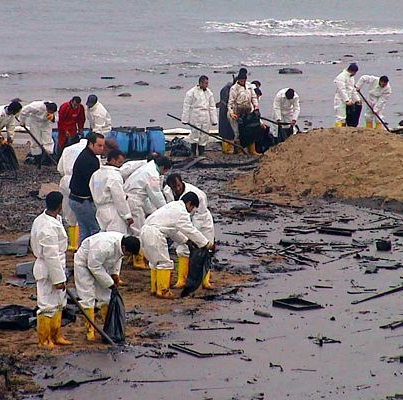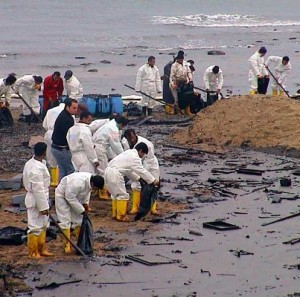
BP unmasks itself
MIAMI – Three years ago, oil giant BP created one of the worst environmental catastrophes in history when one of its wells gushed hundreds of millions of gallons of oil into the Gulf of Mexico. Ever since, the company has carried out an unrelenting public relations campaign to repair its image. But now, when the chips are down and real money is on the table, these corporate suits in the white hats want to avoid full financial responsibility for the damage they caused.

Unless you are of those rare people who never watches television, by now you have seen hours of BP propaganda in the form of countless slick commercials. Their purpose is not to sell the company’s products but to cleanse its image as the perpetrator of one of the worse environmental disasters ever.
They want you to know BP really cares about the environment, the economy, and especially the people of the Gulf coast whose lives were devastated by the explosion of the Deepwater Horizon rig. That’s why they have done all they can to help in the cleanup and in restoring the livelihoods of those who used to make a living from the ocean before BP dropped 4.9 million barrels of crude into their watery backyard.
Now let’s get real. When you turn a former center of fishing, crabbing, and oyster harvesting into a huge oil slick, you never can undo all the damage. Not really. Tar balls are still turning up in Mississippi. Nor can you bring back to life the eleven people that died in the explosion. They and their families are the number one victims, but there are many others.
When it comes to public relations, BP is good. Remember Beyond Petroleum? BP can talk the talk with the best. But when it comes to walking the walk, that’s another story. Currently, BP is in court fighting the federal government over just how much oil escaped during the 87 days it took to stop the spill. As usual, both sides have expert witnesses supporting their side of the story. But this is no mere academic argument. The difference in what the company would have to pay if the judge decides the federal spill estimates are accurate and what BP would lay out if its own figures are accepted is a cool $7.5 billion. We aren’t talking public relations anymore. When it comes to this kind of money, BP is more than willing to drop the Mr. Nice Guy facade.
Ironically, the federal government’s case that a larger spill occurred, than BP now admits, is built on data provided by a pressure gauge on a capping stack installed by BP itself. According to the government, “The pressure data, collection rates, and geometry of the capping stack are by far the most accurate and reliable sources of information on flow rate, and were recognized as such by all parties at the time.”
And it’s not just the feds who think that a spill of 4.2 million barrels occurred (rather than of 2.45 million barrels BP says were spilled). According to ABC News, “Timothy Crone, a professor of marine geophysics at Columbia University, was the lead researcher on what was billed in September 2010 as the first independent, peer-reviewed study of the leak’s volume. Crone and a colleague analyzed underwater video to arrive at an estimate that closely mirrors the federal government’s current calculation of how much oil escaped the well.
“Crone said he is surprised the topic is still being debating three years later. ‘The majority of scientists who worked on the problem are in agreement,’” he said. “I can understand why BP wants to make it a question again, but in my opinion it’s not.”
You don’t have to be a geophysicist to understand that BP has 7.5 billion reasons to cast doubt on what was a settled question. With that much at stake, the company has had no trouble coming up with its own experts who have conjured up any number of scenarios and methodologies which come up with a lower figure. Through this tactic, BP is probably hoping to at least muddy the waters enough that the judge, who is no expert in the oil field, will throw up his hands and come up with a compromise figure that will save the company billions of dollars.
Surprise, after all the posturing BP is showing its true colors. Its actions are shameful, but shame is a feeling of scant significance in the corporate world in general and in the oil business in particular. Here’s an industry that is second only to coal in generating pollutants implicated in global climate change. It also has been a leading player in creating and sustaining the climate change denial movement. Big oil companies like Exxon reap truly colossal profits but each year they fight for and receive a huge amount of corporate welfare from Congress.
With this track record, the fact that BP’s campaign to reinvent itself and project a warm and fuzzy image is a sham only serves to confirm that the tiger has not really changed its stripes.

